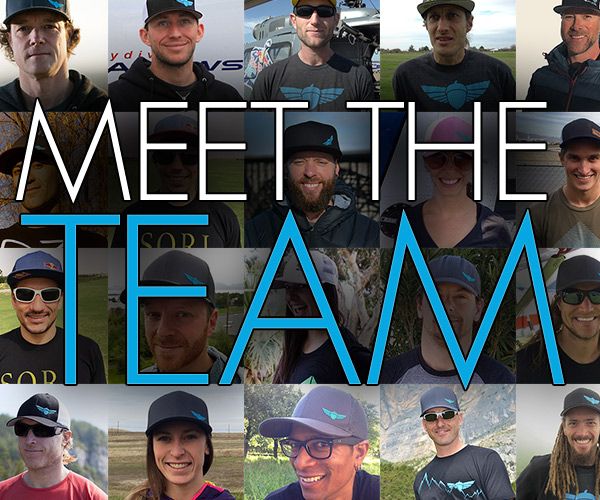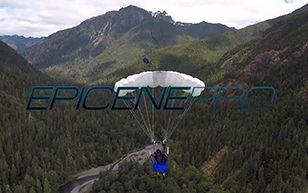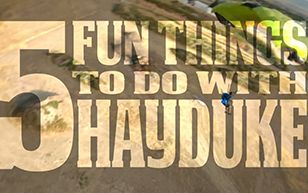Wingsuit Accidents: World’s Most Popular Errors!
Wingsuits add massive amounts of potential to a skydive. We are able to fly vastly further, at much higher horizontal speeds, than on any other type of jump. We can fly a vertical head-down trajectory at 200 mph, or we can flatten out and go for 5+ miles… or we can do both on a single jump! The cost of this amazing benefit, is increased risk and complexity. Increased risk and added complexity means that we need more training and education to maintain the same level of safety. Here is a list of where things commonly go wrong for complacent or undertrained wingsuit pilots.
Hitting the aircraft
Multiple fatalities have resulted from tail strikes, and recently there was a tragic aircraft/wingsuit collision. Hitting the plane is easier to do than many people think. Prevention requires effort and pre-planning.
Prevention: Communicate with the pilot, and be 100% certain that all parties involved understand where the plane is descending. Aircraft settings are critical to exit safety: power should be cut, deck angle should be level, and airspeed should be reasonable. Ultimately, it is up to the wingsuit pilot to exit or not exit after verifying the aircraft settings and aircraft descent pattern. Communication is key - do not assume the aircraft settings are correct, or that the airplane pilot knows where you are going to fly your pattern. And watch this video.
Flying under jump run
This is the first and best opportunity to have a serious collision on a multi-way jump. When exiting the aircraft (we prefer the term “entering the relative wind”), there are multiple chances to lose stability: the jumper can present to the airflow asymmetrically, can tag a part of themselves or their rig on the door, can stall and lose control authority of their suit, or otherwise go unstable. In all of those cases, the likely trajectory is a narrow cone directly below the aircraft. If the base, lead, or previous wingsuit pilot exits the plane and flies along jump run, they are completely exposed to other wingsuiters above them who may have an unstable exit. Many fatalities and accidents have occurred as a result of this, here is one recent example.
Prevention: The base or lead should ALWAYS fly at least 30-45 degrees off of jump run, away from the plane. This holds true whether it is a two-way or a twenty-way jump! The base (lead) should continue on an angle away from the plane, maintaining an awareness of their entire group that is following, and of the planned route of flight.
Stalling above the formation
Approaching a formation or flying a slot vertically above someone else is always dangerous, particularly at lower airspeeds. Stalling into your friends from above can be worse than jumping out of a second story window and head-butting them.
Prevention: Don’t do it. Know what it means to be “on level” in the context of wake turbulence, and if you feel yourself flying on the verge of stall, move out of the formation. Stall configurations mean a loss of suit control because without adequate airspeed, our inputs are useless. Very low airspeed flight is dangerous!
Not being “On Level”
“On Level”… oh, what fun to interpret!
In skydiving, being “on level” does not mean that we are all in a plane, parallel with the horizon. On Level means that we aren’t burbling our friends, or flying in our friend’s burble. The “level” changes with the angle of the jump. In the case of a stacked formation, being on level means that the pilot above you must be staggered forward in the formation, sometimes by a lot (this varies with the glide angle and speed of the formation). Generally, if someone is stacked above you, then they should be far enough ahead of you that their belly button is directly above your head, and the formation is “leaning forward” ahead of the base. This is the single most important factor in building a successful stacked formation. If you are not on level, then you are in the burble (wake turbulence). If you are several rows high in a stacked formation, and you allow yourself to drift back into the wake turbulence, and then lose control of your suit or fall out of your slot and hit someone else, a cascading domino-effect of collisions is the most likely result. This is how people get hurt. Know what is necessary to stay on level, to stay in your slot, and what it means to lose control of your suit at the top of a stacked formation - you have real responsibilities in every formation!
Transitioning above your friends
This is a no-no, in all cases except where the maneuver is carefully trained and currently mastered. Just as bad as transitioning above your friends, is transitioning next to them at an improper angle and allowing yourself to fall off-axis, corking into them from the side.
Prevention: Transition to the side of and below the formation, with no one beneath you, and in a manner that makes a loss of control a non-risk to the rest of the formation, i.e. similar airspeed, and on level.
Losing control in a formation
This is most common when someone feels that “the speed is wrong”. Often, the speed is uncomfortably slow, or fast, or the angle feels unattainable. That is no excuse to lose control of your suit. If the speed is wrong and you can’t hack it, then move out to the side and follow the formation from a close, but safe, distance. Do not leave the formation - see below.
Prevention: If the speed is too slow, or too fast, follow the lead at a safe distance for the duration of the jump. Do not force your way in and risk losing control. Do not go off and do your own thing. Stick with the planned line of flight. If you find it difficult to approach, then approach incrementally and always leave room to clear yourself out to the side of the formation if your approach does not go as planned.
Ditching the Formation
The only way that we can plan a group skydive that flies a predetermined lane for safety, and has a predictable break-off, is if everyone stays in the group. When you bail from the formation, you become a hazard to the rest of the group. Now, we don’t know where you are flying, where you are going to open your parachute, or what heading you might adopt for your deployment.
Prevention: if you get behind, follow the “smoke trail” of the formation, and execute break off at the proper altitude. If you fall out of the formation, find it and watch it from the side, following the smoke trail.
Flaring at deployment
Flaring is fun, and it’s fun to practice!
“And hey, we just broke off, so there is no one around me!” Unfortunately, we can’t know that, and oftentimes there is someone behind or above. We can’t see through the back of our skulls, and a rapid change in vertical speed is a common cause of accidents and near-misses.
Prevention: If you are breaking off from a formation and you do not have a clear visual on every member of your group, do not flare aggressively. If you flare into someone flying above you, the collision speed can be deadly.
Groups interacting
If there is more than one group on the plane, and two groups end up near each other in freefall, the consequences can be severe.
Collisions with parachutes, pulling low, and having too much fun under canopy
Most DZ’s around the world do not appreciate the site of wingsuit pilots buzzing a student or tandem while backflying or carving around in a two way after a formation break-off.
Secondly, most DZ’s don’t like to see wingsuiters (even when flying very docile parachutes) pulling at 1800 feet and then doing CRW all the way to the ground. If you know what you’re doing and the DZ is ok with it, then sure, fly formation or stall your 7-cell canopy. But otherwise, take it easy on these phases of the jump.
High traffic airspace, pull altitudes, and canopy flight patterns are all sensitive areas and not ideal phases of the jump to play around in.
Full disclosure: We do play around under canopy sometimes, but we endeavor to do it in an area of the airport that we know is free of traffic, and at a high enough altitude to be reasonable.
Prevention: When you are approaching the DZ and your breakoff altitude, you will usually be nearing other parachutes from your load. This is not the best time to go to your back and party with your friends at low altitude just before deployment in the most crowded airspace on the jump. Pull above 3,000’, minimum. Fly a predictable pattern and clear any canopy-playtime with the DZSO / S&TA, first.
Cutting Away
Wingsuit cutaways are a serious emergency. As stated in the first paragraph, you can “do more” in a wingsuit than you can without one. The cost of added possibilities is added complexity, and parachute deployment is where this is most apparent.
Landing way the f*ck off
I once heard a story about an experienced wingsuit organizer who went to an invitational wingsuit event, and led every jump on his back. He landed off the DZ 17 out of 22 jumps during the event. I have a low opinion of that person.
Prevention: No coach or organizer is perfect, but we should all consciously strive for perfection when we are leading groups. We should all make great efforts to not just land on the DZ, but to land in a specific part of the landing area on each and every jump. Wingsuits should not decrease the chances of us landing on the DZ, they should INCREASE the chances of us landing on the DZ. Even if the spot is bad, and the wind is strong, we can always make it back if you know where you are when you get out of the plane - all we have to do is plan it, and pay attention. Know the winds aloft, know the winds at opening altitude. Know where you need to fly in order to avoid other groups, and be upwind of your pre-planned opening area. If the visibility conditions are not conducive to navigating back to the DZ easily, ride the plane down.










